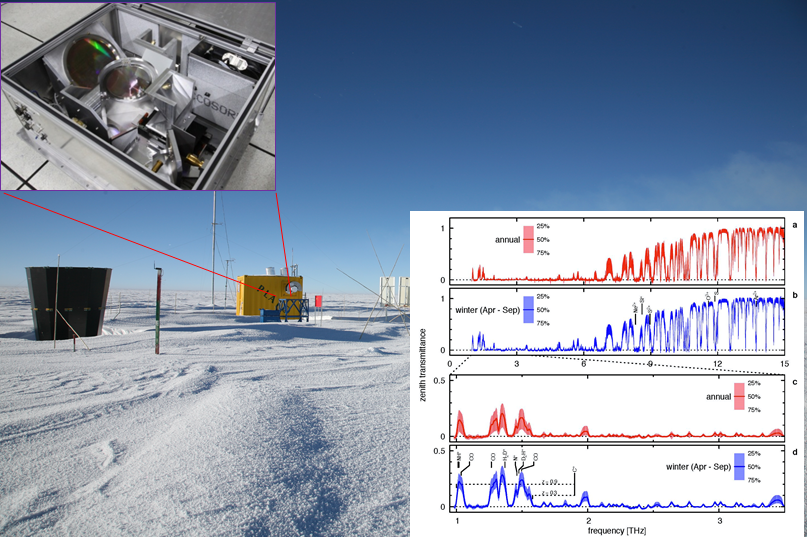Nature Astronomy reports that Sheng-Cai Shi’s team at Purple Mountain Observatory and his collaborators reveal THz/FIR new windows on the Cosmos at Dome A in Antarctic
The THz/FIR electromagnetic spectrum (about 0.3~15 THz in frequency or 1~20 μm in wavelength) is a unique regime for observing the universe, such as cold gas and dust cradling new born stars, and rich molecular rotation lines and fine-structure atomic lines tracing the interstellar medium. Due to the absorption of water vapor, however, nearly all of the Earth’s surface is opaque in this regime. Dome A in Antarctic has a high altitude (4093 m) and very low temperature (down to minus 80 degrees) characteristics, precipitable water vapour (PWV) at Dome A is only one tenth of that at a famous astronomical observation site -- Mauna Kea in Hawaii. Dome A has been selected as the candidate site of “China Antarctic Observatory." Sheng-Cai Shi’s team at Purple Mountain Observatory, in collaboration with researchers at Harvard-Smithsonian Center for Astrophysics and other institutions, has developed an ultra-wideband (0.75~15 THz) Fourier Transform Spectrometer (FTS) in unattended mode of operation. This instrument was deployed to Dome A in January 2010 by the 26th China Antarctic expedition team, and put into continuous operation for about 19 months. It is the first time to measure long-period atmospheric transmittance spanning the THz/FIR spectrum at Dome A (see figure below), exposing new THz/FIR windows that are difficult to observe at other ground sites. In addition, new broadband spectra with auxiliary data on the atmospheric state over Dome A set new constraints on the spectral absorption of water vapour at upper tropospheric temperatures important for accurately modelling the terrestrial climate. This study has demonstrated that Dome A in Antarctic provides new opportunities for astronomy and atmospheric science research.
The related paper will be published in the first issue of Nature Astronomy in January of 2017 , firstly released online on December 13 (http://www.nature.com/articles/s41550-016-0001). The authors of this paper include Sheng-Cai Shi (first and corresponding author), Qi-Jun Yao, Zhen-Hui Lin, Wen-Ying Duan, Xin-Xing Li (now with Suzhou Institute of Nano-Tech and Nano-Bionics), and Ji Yang of PMO (CAS, China), Scott Paine and Qizhou Zhang of CfA (US), Hiroshi Matsuo of NAOJ (Japan), M.C.B Ashley of UNSW (Australia), Zhaohui Shang of TNU/NAOJ (China) and Zhong-Wen Hu of NIAOT/NAOJ (China). Primary support for this research was provided by the Operation, Maintenance and Upgrading Fund for Astronomical Telescopes and Facility Instruments, budgeted from the Ministry of Finance of China (MOF) and administrated by the Chinese Academy of Sciences (CAS). This work has been supported by the 26th and 27th Chinese Antarctic expedition team, the PLATO team, and the Antarctic Astronomical Center of CAS.

By with SHI Shengcai
Figure. (background) Photo on site at Dome-A, (top-left) Internal photo of FTS mounted on the PLATO platform, Zenith atmospheric transmittance spectra measured at Dome A, Antarctica, during 2010–2011. a–d, Spectra are shown for the entire year (a,c) and for winter (April–September) only (b,d). Quartile statistics for each frequency channel were compiled independently. Solid lines indicate the median transmittances, and the shaded regions show the interquartile ranges. To account for irregular time sampling throughout the year, data were de-biased as described in the text. Frequencies of several astrophysically important spectral lines are indicated; note that some of these lines are observable only at certain non-zero redshift values z.
